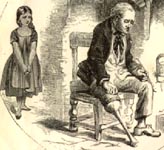Nineteenth-Century American Children and What They Read

This site is devoted to the examination of 19th-century children in America: what they read, what was written about them, and what was written for them. "Children" includes letters, adoption advertisements, paper rewards for obedient children, 24 contemporary articles for and about children, and 14 photographs, as well as scrapbooks and exercise books. "Magazines" features illustrations, articles, editorials, and letters from 12 different children's magazines, with cover and masthead images from 173 different volumes. "Books" includes 22 articles on children and reading (including one warning children to avoid mental gluttony by not reading too much), and the full text of 29 books, including the American Spelling Book and grammar primers. Although the site is not searchable, the documents are indexed and arranged by subject. The site includes eight analytical essays written by modern scholars, a timeline covering the years 1789 to 1873 (with entries covering subjects like magazines, books, historical events, and people), and eight separate bibliographies. A "puzzle drawer" includes word games played by 19th-century children.


